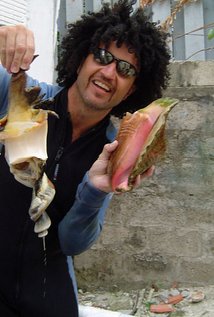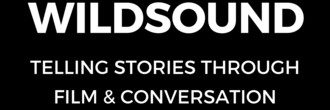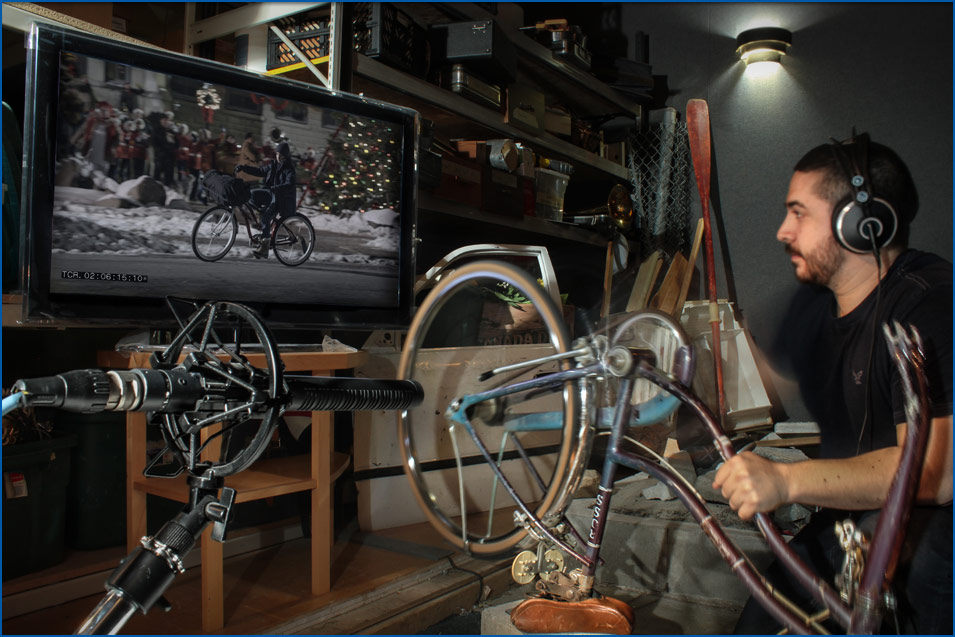Foley is the reproduction of everyday sound effects that are added to film. These reproduced sounds can be anything from the swishing of clothing and footsteps to squeaky doors and breaking glass.
I was very fortunate to sit down with the brilliant and under appreciated Foley Artist Mark Costanzo. Marko has worked on over 500 productions and is a 2 time Emmy winner. (If the Academy had a category for Foley, Marko would have won more than a few Oscars.)
His list of credits consist of many of the greatest films of the last 30 years. See his IMDB list: http://www.imdb.com/name/nm0003401
 Matthew Toffolo: Out of all the amazing films you’ve worked on, is there one or two that stand out that you’re most proud of?
Matthew Toffolo: Out of all the amazing films you’ve worked on, is there one or two that stand out that you’re most proud of?
Marko Costanzo: Wow!!! That’s a really hard choice. I have favorite movies that were really challenging to work on and others that I love just for themselves. “Oh Brother Where Art Thou” and “Life of Pi” and “Good Fellas” and “The Birdcage” and “Boardwalk Empire” and ….
Matthew: I just watched “Spotlight”, a film you were the Foley Artist on. There is a theme of “silence” in the sound design: What is not heard/What is not said. Was working on that film the definition of “less is more” when creating the sound effects?
Marko: Spotlight was indeed a wonderful film. There were many times where subtlety was more necessary than the normal amount of noise we add to the sound tracks. A tense moment can be emphasized with the nervous creak of leather or a sweaty brow wipe. Of course music is a key component to creating the mood for a scene, and the mixer was able to capture those moments with music and effects. A sprinkling of foley can enhance those times. We pretty much do what is required and “less is more” was indeed the intention for some moments.
Matthew: What makes a great foley artist? What skills does he/she need?
Marko: There are many great foley artist out there. I have worked with truly talented individuals that have amazed me with their abilities. To be a great foley artist I believe one must have relatively good reflexes. Eye-hand coordination is key to making a sound believable. Many times a sound can be perceived as correct if the sync is perfect.
You need to have some common sense and an imagination that can take you to the limits of an effect. Choosing what prop to use for the sound you want to make is essential. Like a chef, you look to see what sound you need to make, then chose the ingredients (props) and mix them together.
You need to be a good listener. We work for editors. Editors have different criterion for each show we work on. Some like it big and over the top. some like it subtle and more realistic. Each time a different foley editor would come into the room to supervise the recording, I would walk away with a better understanding about how things should sound. It’s important to gain the trust of your editors and listen to what they have to say. When they want something heavier you need to understand what they mean. Does heavier mean louder? Bigger? It’s a subjective art with lots of possible variations. It’s important to do things the way the client intends for it to be heard.
It helps to be a dancer or a mime or an athlete. This is a physical job that requires strength and coordination. I’m a 6 foot tall male weighing about 180 pounds trained in the marshal arts, acting and also a student of prestidigitation. I’ve trained myself to sound like a construction worker or an executive or a mobster or a messenger. Those are just some of the roles for men. I can also sound like a little child running on a playground or a sexy model clomping across a runway in stiletto heels. ( I have many pairs of 13-Wide woman’s shoes). You need to be able to portray, (through the body language of the actor) what emotion they are presenting. If an actor is acting drunk, those footsteps had better sound like they are coming from a drunken person, and not the straight forward footsteps of a business man on the way to work.
Matthew: How did you get started as a foley artist? Was it something you knew about growing up and dreamed of doing? Or did the job choose you?
Marko: At age 15 i was a practicing magician performing tricks for aunts and uncles and friends and local children. I wanted to be a Magician when I grew up. I was also involved with the drama department throughout high school and college. My major was business management, but I took as many film and television courses as possible. I wanted to be in front of the camera for all those years.
When I graduated I immediately started working on low budget feature films being shot in NYC. The was fun and I thought I would be working on sets as a grip or anything. I started to think I wanted to direct as well. It wasn’t until a friend introduced me to a post production studio in Manhattan did I even realize that Foley existed. I got involved in editing and one day they said I should go to the foley stage and watch what was going on. Elisha Birmbaum was the Foley Artist working on Sophie’s Choice. I watched as he moved in sync with the characters on screen. At one point they needed a pull chain light bulb sound and Elisha was not able to find a prop suitable prop for this effect. I immediately said I had one in my father’s workshop and would bring it to them the following day. I was permitted to make the foley sound for this. Afterwards I was told Elisha (NYC’s premier Foley Artist for 30 or so years) was looking for a replacement. I applied for the position and I have never looked back.
Matthew: Many of the movies you work on (including working with Martin Scorsese, Spike Lee, and Woody Allen) are based in New York City. I’m assuming that’s where you were born and raised and are an expert at understanding the “pulse” of the city?
Marko: My entire working career has always been in NYC. From stand-up Comedy Clubs to working on the streets on low-budget films to landing the Foley Artist position at Sound One. It was always very exciting to be around the directors and actors that would come into sound stages and replace their voices or work on the editing of the film. I actually lived in Fort Lee, New Jersey for most of my career, which gave me easy access into Manhattan. Being a commuter into the city was a time consuming process and when given the opportunity to work on a Foley stage in New Jersey, I chose to give up the NYC life. C5 the Post Production Sound Facility I have been working with for the past 27 years build the largest facility for foley recording in the USA. It was 20 minutes from my house in a very quiet neighborhood. We have the capability to record huge sounds with our “LIVE” sound reflecting walls and more storage space for props than anyone could have imagined.
Matthew: How long does is generally take to do the foley for a feature film?
Marko: Foley recording for feature films vary tremendously from film to film. It usually boils down to the budget of the film. Nowadays, there is a surge of feature films and television shows that all require some Foley recording. Here is a general breakdown for Film and Television.
Low-budget films will allow 2-5 days of recording with some editing to tighten up the loose sync.
Most 1/2 hour or 1 hour televisions series will use 1-2 days
Medium budget films will get almost 2 weeks, depending on whether it is an action film or other type of sound intensive show.
Big Budgets will usually take 3-5 weeks. These films expect every nuance of sound imaginable.
Matthew: Is there a different game-plan in developing the sound when working on different genres (drama, comedy, action, comic book)? Or working on period pieces (like Boardwalk Empire) in comparison to a modern film?
Marko: I find that everyone we work with follow their own set of rules as to how a film is prepared for the final mix. Sometimes the sound supervisor will create lots of library sounds for as many scenes as they are capable of preparing. When they have exhausted their library of effects or their time for preparation, then the foley team will be given a list of what is still needed to be recorded.
Sometimes we go through the entire film and put Foley Sounds in for every possible moment. It really depends on how fast a project needs to get completed and how much money is available for post production. Foley is the fastest method for getting great sounds in sync with the actions on screen, but certainly not the cheapest. The Sound Supervisor needs to balance his budget and make sure the project get completed properly, in a timely manner and to the liking of the director.
Matthew: Besides the films you’ve worked on, what film have you seen the most in your life?
Marko: Brazil, Planet of the Apes, Star Trek, Caddy Shack, Pulp Fiction. I love comedies, science fiction and quirky films. And for as many years that I have been in the film industry, I seldom just listen to the sound tracks of a film. I tend to get involved in the actors and what they have to say. Everything else in the film is usually just background. I want to hear what the writer is trying to say. I just recently viewed “The Reverant”. This film was beautifully shot, with music guiding the emotion of each scene. The effects tracks and foley was pristine and captivating. It is truly one of the best films I have seen.
Matthew: Who is/was your sound/foley artist mentor?
Marko: In the beginning Elisha Birmbaum of Sound One gave me my first opportunity in being a Foley Artist. Working at Sound One for the first five years of my career enabled me to meet and understand the many different people and ideas from all the different editors milling about in the Brill Building (the center of the NYC film industry for many years). All the editors and directors that came into the studio helped mold my tastes and judgements. When I joined C5, there was a different mind-set used in the creation of Foley Sound’s. The intention was to create foley sounds that blended with the production tracks by using reflective walls and various surfaces. I was fortunate to be invited to work with some of the best sound people in the business.
Matthew: You’ve worked on some of the greatest films made in the last 30 years, with basically all of the greatest filmmakers of our time. Is there someone you would like to work with that you haven’t worked with yet? Or, is there a film subject/genre that you like to work on?
Marko: I have been blessed with being in a position that offers so many unique projects to work on. I never know where the next interesting show is coming from. For years I wanted to work with Ray Romano, whom I had performed with during his comedy years. I was pleased to see him in HBO’s upcoming series “Vinyl”.
I recently was asked to make Foley sounds for a Neuro-science project with David Byrne.
The Coen Brothers and Charlie Kaufman asked me to perform Foley live on stage for “Theater of the New Ear”. This was a sound play performed here in NYC, England and Los Angeles.
Last year I flew out to L.A. to put Foley Sounds to Charlie Kaufman’s “Anomalisa”, (one of the sound plays I did live for “Theater of the New Ear”). I never know what direction this craft will take me.
Matthew: People are reading your interview and are now fascinated about your job. I’m sure the next film/TV show they watch, they are going to pay more attention to the foley. What film(s) of yours should they watch, learn and take in the artistry of what you do?
Marko: I always kid with people about waiting to see the credits. Everyone I know now waits to see if i worked on the film they just saw. It’s flattering, but I work on about 20 movies a year. there are close to 300 major feature films released each year. There is a big chance that the movie they are watching in not bearing my name… but they still wait and look and comment of the way the foley sounded to them. The greatest compliments I receive are when the listener can’t detect there is any foley at all. It means the foley blended with the production perfectly and we did our job properly.
In any event, if you’d like to see my credit roll up the screen, be sure to watch Spotlight, Queen of Katwee, The Free State of Jones, Vinyl, Chiraq, The Knick… AW SHUCKS!!! here’s my IMDB link:
http://www.imdb.com/name/nm0003401/?ref_=fn_al_nm_1
—
—-
Interviewer Matthew Toffolo is currently the CEO of the WILDsound FEEDBACK Film & Writing Festival. The festival that showcases 10-20 screenplay and story readings performed by professional actors every month. And the FEEDBACK Monthly Fesival held in downtown Toronto on the last Thursday of every single month. Go to www.wildsound.ca for more information.


Reblogged this on Festival Reviews.
LikeLike
Reblogged this on WILDsound Writing and Film Festival Review.
LikeLike
Reblogged this on Thriller/Suspense Film and Writing Festival.
LikeLike
Reblogged this on Festival for Drama in Film, Screenplays, Novels.
LikeLike
Reblogged this on TV Screenplay Festival. Submit Today..
LikeLike
Reblogged this on Crime/Mystery Film & Writing Festival.
LikeLike
Reblogged this on First Scene Screenplay Festival.
LikeLike
Reblogged this on WILDsound Writing and Film Festival Review.
LikeLike
Reblogged this on WILDsound Writing and Film Festival Review.
LikeLike
Reblogged this on Under 5 minute film festival.
LikeLike
Reblogged this on Comedy FESTIVAL.
LikeLike
Reblogged this on WILDsound Writing and Film Festival Review.
LikeLike
Reblogged this on WILDsound Writing and Film Festival Review.
LikeLike
Reblogged this on WILDsound Writing and Film Festival Review.
LikeLike
Reblogged this on Festival for HORROR.
LikeLike
Reblogged this on WILDsound Writing and Film Festival Review.
LikeLike
Reblogged this on WILDsound Writing and Film Festival Review.
LikeLike
Reblogged this on WILDsound Writing and Film Festival Review.
LikeLike
Reblogged this on WILDsound Writing and Film Festival Review.
LikeLiked by 1 person